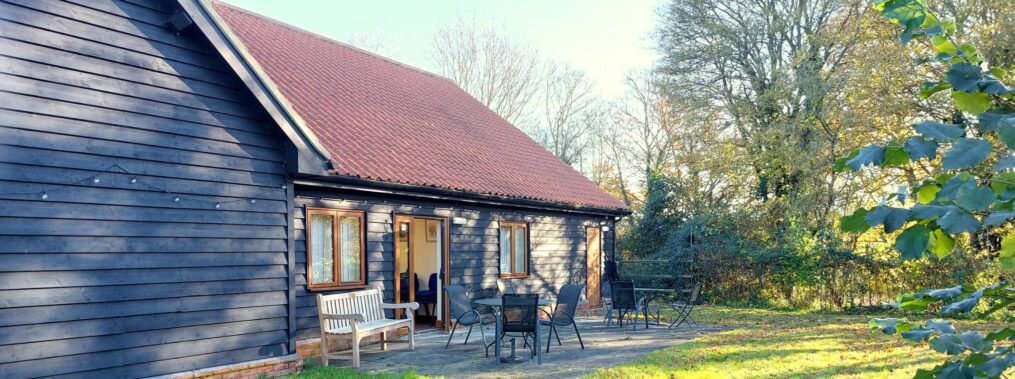The official title of our village hall is the Drinkstone War Memorial Institute and it has had a long history.
On 30th July 1920 the Ministry of Munitions, by direction of the Disposal Board, Huts and Building Materials Section, held an auction at the former First World War Elmswell Airfield (sometimes referred to as Great Ashfield). One of the huts on the site – an officers mess, cookhouse block of 75 [Home Defence] Squadron, RFC – with dimensions of approximately 71ft by 29ft, corresponds to the dimensions of what became the Drinkstone War Memorial Institute (Village Hall).
In 1921, a piece of land (Elm Tree Meadow) in Drinkstone was bought from Mr Thompson of Rookery Farm for around £26 for the purpose of erecting a village hall as a war memorial for the parish. The parish priest, The Reverend Francis Herbert Horne, played a prominent role in this project.
According to local accounts, ‘an officers dining hall from the airfield at Great Ashfield was brought to Drinkstone in sections by horse and cart’ at some time between 1920 and 1922, and was re-erected and dedicated as the official village war memorial. The earliest documentary evidence of its community use, so far discovered, is in the Bury Free Press of Saturday 11th March 1922. The report refers to “A social held in the newly-opened Memorial Hall” raised £9 11s with an attendance of around 130 people. A further report, in the Bury Free Press of 31st January 1925, gives an account of an Annual General Meeting for the Institute that took place that month. It is reasonable to suppose that the AGMs took place approximately one year after the previous committee had been elected, suggesting that the DWMI was initially opened during a January too (in 1922?).
A minute book recording the management committee meetings between January 1928 and January 1969 came to light in September 2016 and refers to activities in the Hall from at least 1927.
The hall occupies a special place in the hearts of generations of villagers and others further afield. It witnessed numerous family, community and national celebrations over the years, including weddings, dances, fund-raising events, coronations and other royal occasions. During the Second World War, American servicemen based locally used the hall for various events too, including ‘hops’ where musicians from the legendary Glen Miller Orchestra played. In 1951 a charitable trust was established to administer the village hall on behalf of the community.
A potentially catastrophic fire at the hall in September 2010, caused by an electrical fault, damaged the front end of the hall and prematurely brought it’s working life to an abrupt halt. Up to that point the hall had been well-used by the local community, almost on a daily basis. Rather than merely demolish the historic building, the desire to find it a new role led to enquiries being addressed to various aviation museums and enthusiasts across southern England. Finally, the Stow Maries Aerodrome Museum expressed an interest in re-erecting the building at their site.
The hall was carefully dismantled during April 2011, with the major part of the cherished old village hall being saved. At least five of the six roof trusses were salvaged and the majority of the walls and floor sections and some windows were in good enough condition to be kept. A party of volunteers from Stow Maries arrived at 9am on Sunday 5th June 2011 and it took them some seven hours to completely fill two large lorries. The ‘move’ was featured on BBC TV’s ‘Look East’ that evening. Disappointingly, the Stow Maries Museum did not fulfil the undertaking they had made to re-erect the Hall at their site, potentially as an educational area for school visits, and the parts remained stacked on part of their site.
In 2016 a message was received from Taff Gillingham, one of the team behind the Great War Huts project at Hawstead, Suffolk, saying that Stow Maries had given them the old village hall for re-erection at their museum site – fewer than 10 miles from Drinkstone! Sadly, a subsequent message from Taff revealed that the sections of the building had been left outside, at the mercy of the elements and most of the best timbers had been robbed to repair other buildings at Stow Maries. Little remained – no more than one tenth, and not even a single window.
There is one chink of light in the sad demise of Drinkstone’s original War Memorial Institute that Taff was able to shine. He asked the District Planning Officer if the remains of the village hall might be used as the basis for the café on the Hawstead site. It would not be a complete hut by any means, but at least if permission is granted, Drinkstonians will be able to have a cup of tea and a piece of cake in what is left of the old Institute.
Meanwhile, a modern replacement village hall was built and opened in July 2013. The new Drinkstone War Memorial Institute flourishes and still serves as a busy social hub for the village, ensuring that those who died in two World Wars are still remembered and honoured by suceeding generations of Drinkstonians.
Last revised, January 2022

